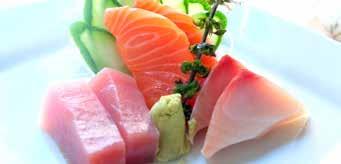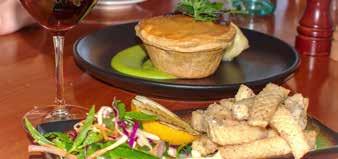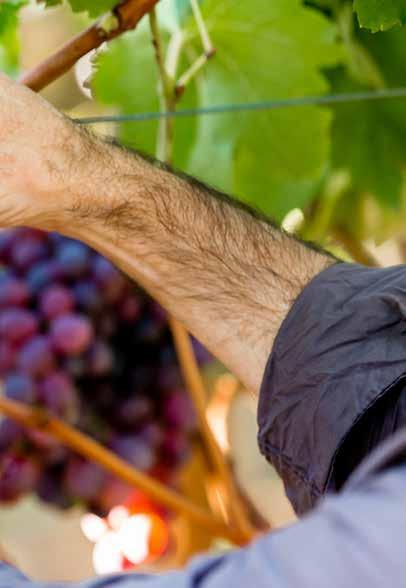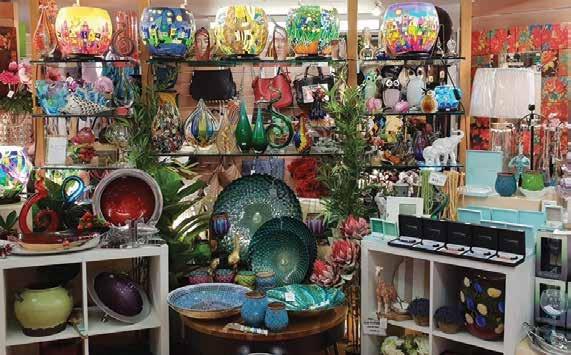
8 minute read
Summer Dining Guide
THE WOOD RESTAURANT
Located at Brokenwood Wines magnificent new cellar door facility (voted best in the Hunter Valley 2019) The Wood Restaurant’s contemporary menu features quality locally sourced ingredients, prime cuts and market fresh seafood, cooked simply with flair.
Located at Brokenwood Wines, 401-427 McDonalds Road, Pokolbin, MAP REF L10 | PH 4993 1193 | Open 7 days for Lunch; Dinner Friday and Saturday
The name says it all... Delicious. Open daily, Oishii has become one of the most popular eateries in the epicentre of Hunter Valley wineries and concerts. The market fresh seafood Sushi and Sashimi followed by a rich Massaman Beef Curry and finished with fried ice cream - a house speciality, begs a return visit to taste their unique Prawn Tempura, Panang Duck Curry and Green Curry Chicken. OISHII JAPANESE THAI RESTAURANT

Roche Estate, Cnr Broke & McDonalds Rd’s Pokolbin, MAP REF L11 OPEN 7 Days Lunch, Dinner + T/A | 4998 7051 | www.oishii.com.au
BLAXLAND INN

Specialising in friendly country hospitality, you’ll love your time at Blaxland Inn. Our menu is full of hearty meals from succulent steaks, house-made pies, and our signature garlic prawns. When reserving your table, ask about our courtesy vehicle. Suitable for up to 11 guests, conditions apply. Bookings are essential.
ESCA BIMBADGEN

Esca Bimbadgen showcases Bimbadgen wines by matching them with simple, elegant food in a jaw dropping setting. A pioneer of fine dining, Esca Bimbadgen exemplifies the unique nature of a winery restaurant. The spectacular entrance suspended above the winery is second only to the view from your table.
790 McDonalds Road, Pokolbin, MAP REF H12 | PH 4998 4666 esca@bimbadgen.com.au | www.bimbadgen.com.au/dining OPEN Sun to Thurs 12pm–3pm, Fri & Sat 12pm–3pm; 6pm–9pm
THE CELLAR RESTAURANT

The Cellar Restaurant delivers modern contemporary Australian cuisine, utilising local and seasonal quality ingredients. Dine in our indoor garden setting or outside in the courtyard. Try our NEW al a carte and tasting menu! Share plates are also available for lunch Monday to Sunday. Bookings recommended.
HVG Village, Broke Rd, Pokolbin, MAP REF K10 | PH 4998 7584 admin@the-cellar-restaurant.com.au | OPEN Lunch Mon–Sun; Dinner Mon–Sat | www.the-cellar-restaurant.com.au
RESTAURANT CUVEE

Restaurant Cuvee specialises in fresh, local produce for breakfast and lunch menu. Famous for our bubbly breakfast, enjoy delicious bubbles with a wholesome big breakfast or stop in for lunch and experience our perfectly wine matched a la carte menu, catered to all foodie types. Don’t forget to drop by on weekends and try the Oyster Bar serving up fresh seafood against a stunning view! Cnr of Broke Road & Wine Country Drive, Pokolbin, MAP REF K14 PH 4998 7881 | cuvee@petersonhouse.com.au www.petersonhouse.com.au | OPEN 7 days Breakfast & Lunch
CLIMATE Change

Impacting Wine as
We Know It
There is no doubt that there is still much climate change denialism. But for many industries, and especially those working in the global wine industry, climate change is a harsh reality.
A changing climate is nothing new to agriculture, but the severity of change has become a prominent concern for farmers. Prolonged drought, spring frost, hotter than average temperatures, unseasonal rain events and hailstorms and a deterioration of seasonal predictability are all challenges facing the grape growers of today.
The global wine industry has been forced to evolve more in the last 20 years than ever before. In 2017, wildfires destroyed nearly 250,000 acres of land across the Napa Valley in California, while all over France, extreme freezes are the new norm. More recently, in Australia, lengthy droughts and massive wildfires have devasted wine regions throughout the country.
South Australia’s Adelaide Hills area has been the most affected wine region in the country with December temperatures soaring to 43.9°C, and a fire that enclosed almost 3,000 acres of the regions vineyard area – destroying around 30% of Adelaide Hills’ production.
Wine regions in Queensland, New South Wales South Australia and Victoria, have all been affected. This includes Hunter Valley, Canberra, Rutherglen, Gippsland and Adelaide Hills. All face an uncertain 2020 vintage, as the effects of smoke taint and heat on this year’s crop remain unknown.
yhv 36 | FEB-MAR 2020 Over the years, winemakers have learned how to deal with the effects of the extreme and hotter weather – by watering the vines more frequently (if they have water available), by more effectively managing the vine canopies to provide optimal leaf shading for the bunches, by mulching their vineyards to retain moisture in the soil beneath the vines and by doing whatever is required in to minimise soil moisture loss. Some are even switching their vine plantings to cooler and less exposed parts of their properties.
Climate change is increasingly a significant challenge in wine production, and the frequency of extreme climatic events (hail, flooding, drought) is likely to increase. Depending on the region and the amount of change, this may have positive or negative implications on wine production and quality.
What is clear, though, is that adaptation strategies are needed to continue to produce high-quality wines, and new research indicates that substituting the traditional grapes varieties for other more drought and heat-tolerant varieties could well offer a way forward for winemakers. But for a winegrower, simply switching to a more heattolerant variety is not an easy decision and requires replanting vines – which would take more than ten years to establish. The accelerating effects of climate change are forcing the wine industry to take decisive steps to counter or adapt to unpredictable weather patterns.
Growing Gapes in Places Previously Considered Unsuitable On the flip side, climate change has made winners out of some regions that traditionally had trouble ripening grapes or where vines would not have been able to survive previously.
As the climate has warmed, regions that were once considered too cold are now indicating that they can also produce fine wine, as long as the other elements are in order.
Germany’s Rieslings and the Loire Valley’s Cabernet Francs are enjoying more reliable harvests, year after year than they were even a decade ago. England is another example, where English sparkling wine

is challenging Champagne. Until recently, nobody had ever heard of English sparkling wine, but as the climate has warmed, a world-class sparkling wine industry has developed along the southern coast of England with new vineyards being planted at a rapid pace.
Closer to home in Australia, winemakers are now increasingly looking toward investing in regions such as Tasmania, which is producing some outstanding Shiraz, typically considered a warmclimate variety. Seeking Higher Ground In some parts of the world, producers are planting vineyards at altitudes once considered unsuitable to growing wine grapes. Today, vineyards in the regions of Salta and Jujuy in northern Argentina can be found at altitudes of between 1,500 and 3,300 metres and are considered among the highest in the world. Similarly, in the Walla Walla Valley of Washington State, growers are experimenting at 900 feet. There are no hard-and-fast rules that limit the altitude at which grapes can be planted. It ultimately depends on a region’s climate, the quality of light, quality and type of soil, access to water and variety of grape. But as the earth has warmed, vineyards are moving higher.
Experimenting and Planting with Alternative Grape Varieties The Australian wine industry currently relies heavily on the popular grape varieties of Shiraz, Cabernet Sauvignon, Pinot Noir, Chardonnay, Sauvignon Blanc, Pinot Gris, amongst others – most of which originate from France and are now widely planted throughout Australia’s 65 wine-producing regions.
While these varieties are and will continue to be extremely important to the Australian wine industry, there is a growing need to identify and cultivate those alternative grape varieties that are better suited to the ongoing challenges of the Australian climate (and changing consumer palate).
Wine researchers are investigating heat and drought tolerant grape varieties from other regions such as Cyprus for their suitability to the Australian conditions. The Cypriot varieties of Xynisteri (white) and Maratheftiko (red) have been cultivated for thousands of years in Cyprus, tolerating scorching, dry summers, surviving on winter rainfall alone.
Throughout Australia, wineries are responding to climate change by reducing their carbon footprint, practising more environmentally friendly viticulture, adapting their methods and planting different grape varieties that include (amongst others) Barbera, Nero d’Avola, Grenache, Sangiovese, Mourvedre, Vermentino and Mencia.
Other varieties considered suitable to the Australian climate include Plyto from Greece, Areni from Armenia, Shavkapito from Georgia, Gouveio from Portugal and Bobal from Spain.
Over the next few years, you can expect many of these wines to become increasingly known and popular with wine drinkers and perhaps close the gap on some of the mainstream varieties. ■
CLEARANCE SALE UP TO 50% OFF
Wine Glass Gallery


• Largest range of wine glasses in the Hunter Valley • Hand painted Hunter Valley souvenir wine/shot glasses • Various artworks • Amusing collector teapots • Amazing selection of glass platters, vases & ornaments • Beautiful seasonal scarves • Wonderful jewellery, handbags & interesting giftware • Aboriginal products • Hunter Valley T-Shirts • Great range of Australian souvenirs
Come and see our colourful eclectic products & experience our helpful, friendly Hunter Valley Service!










